Facile Synthesis of SrCO3-Sr(OH)2/PPy Nanocomposite with Enhanced Photocatalytic Activity under Visible Light
Abstract
:1. Introduction
2. Results and Discussion
2.1. Characterization
2.1.1. Chemical Composition
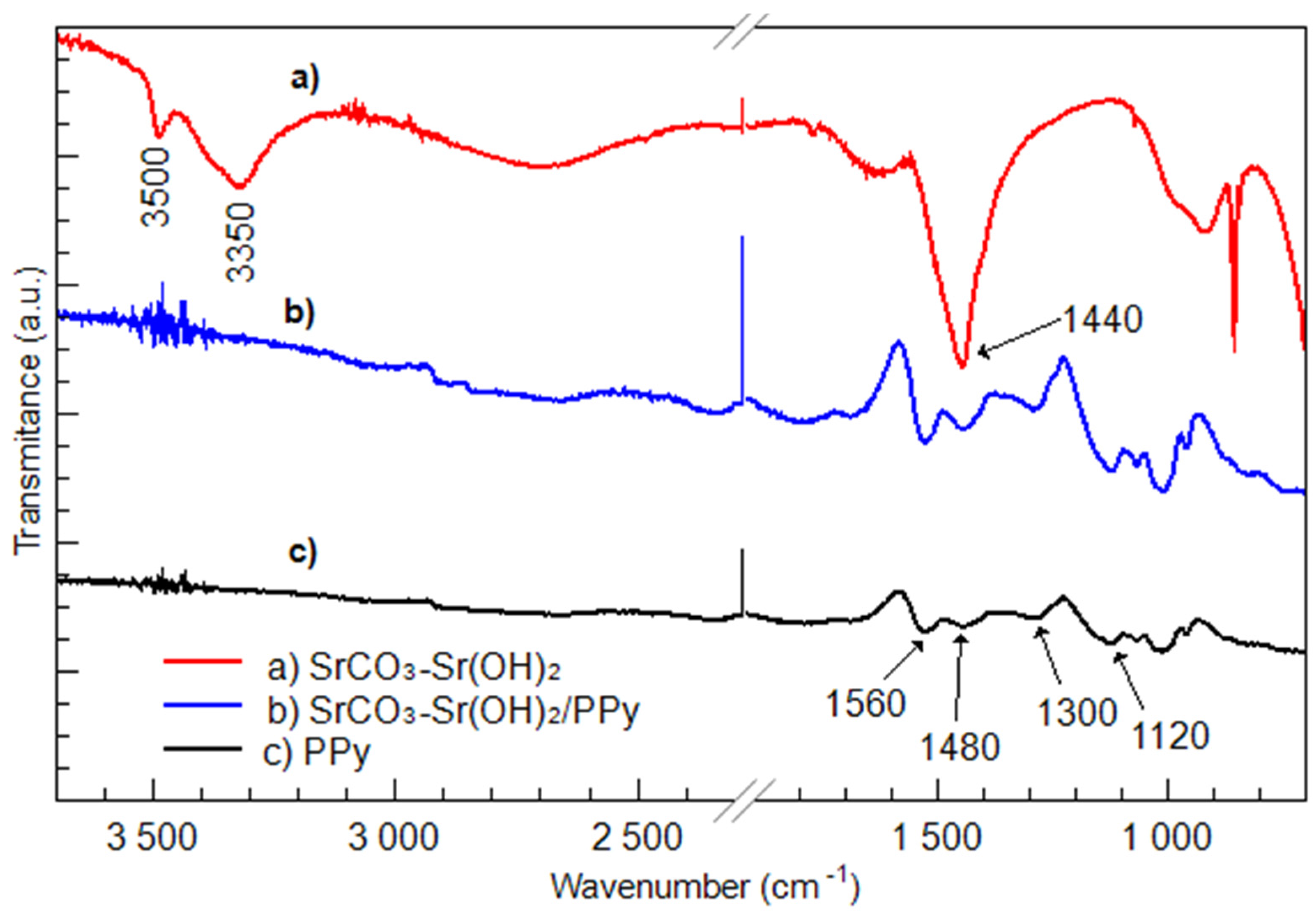
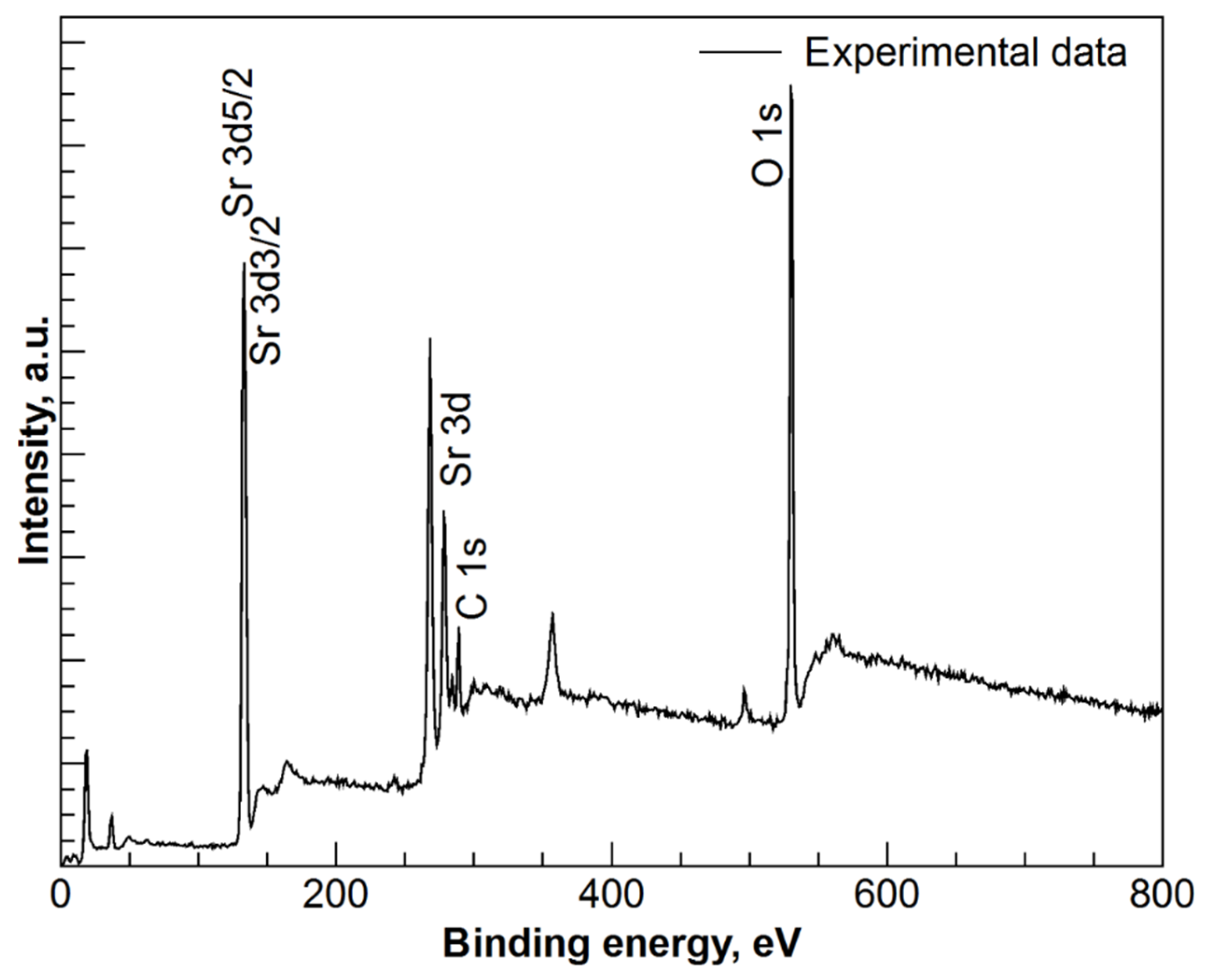
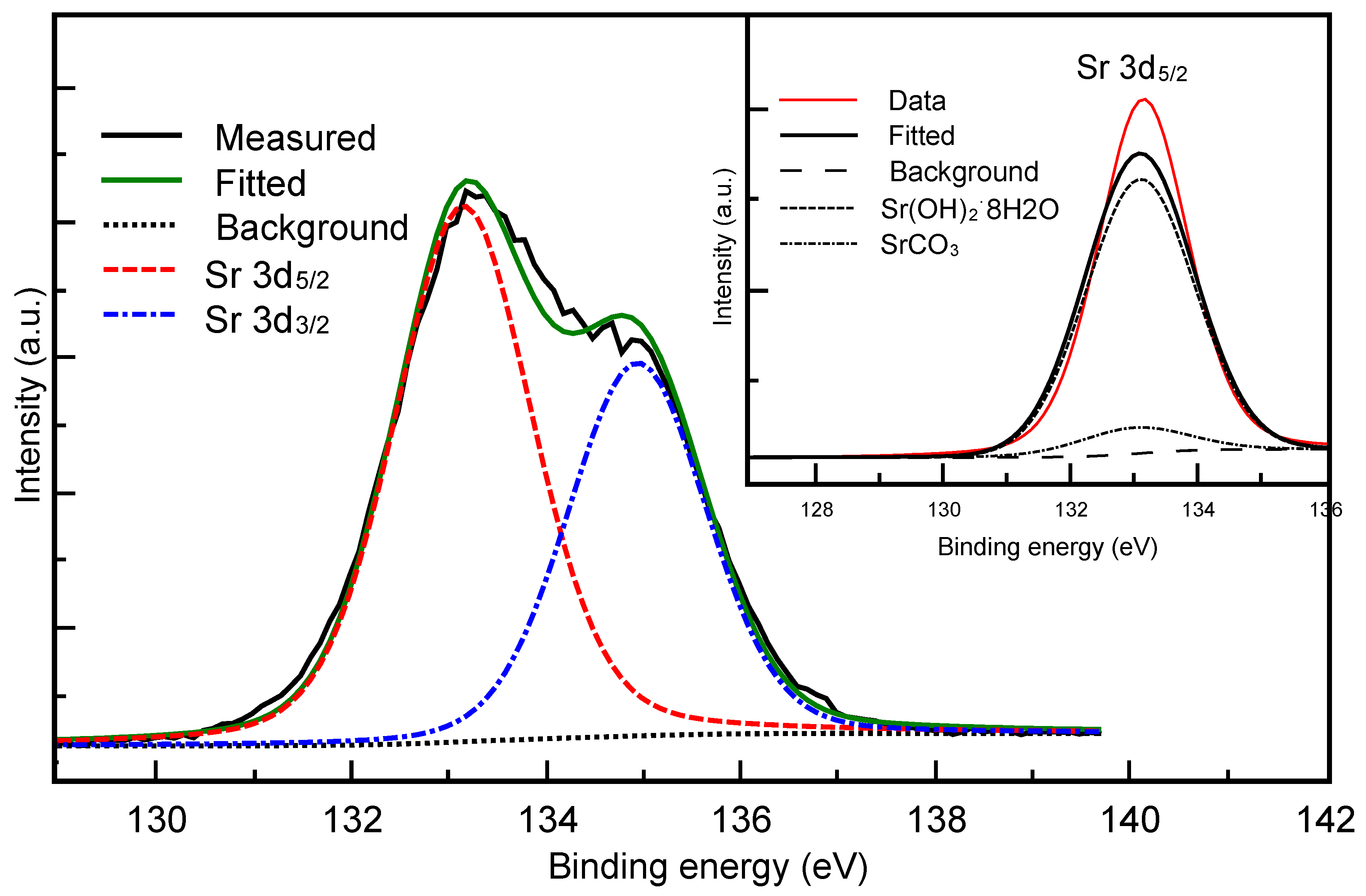
2.1.2. Crystallinity and Morphology
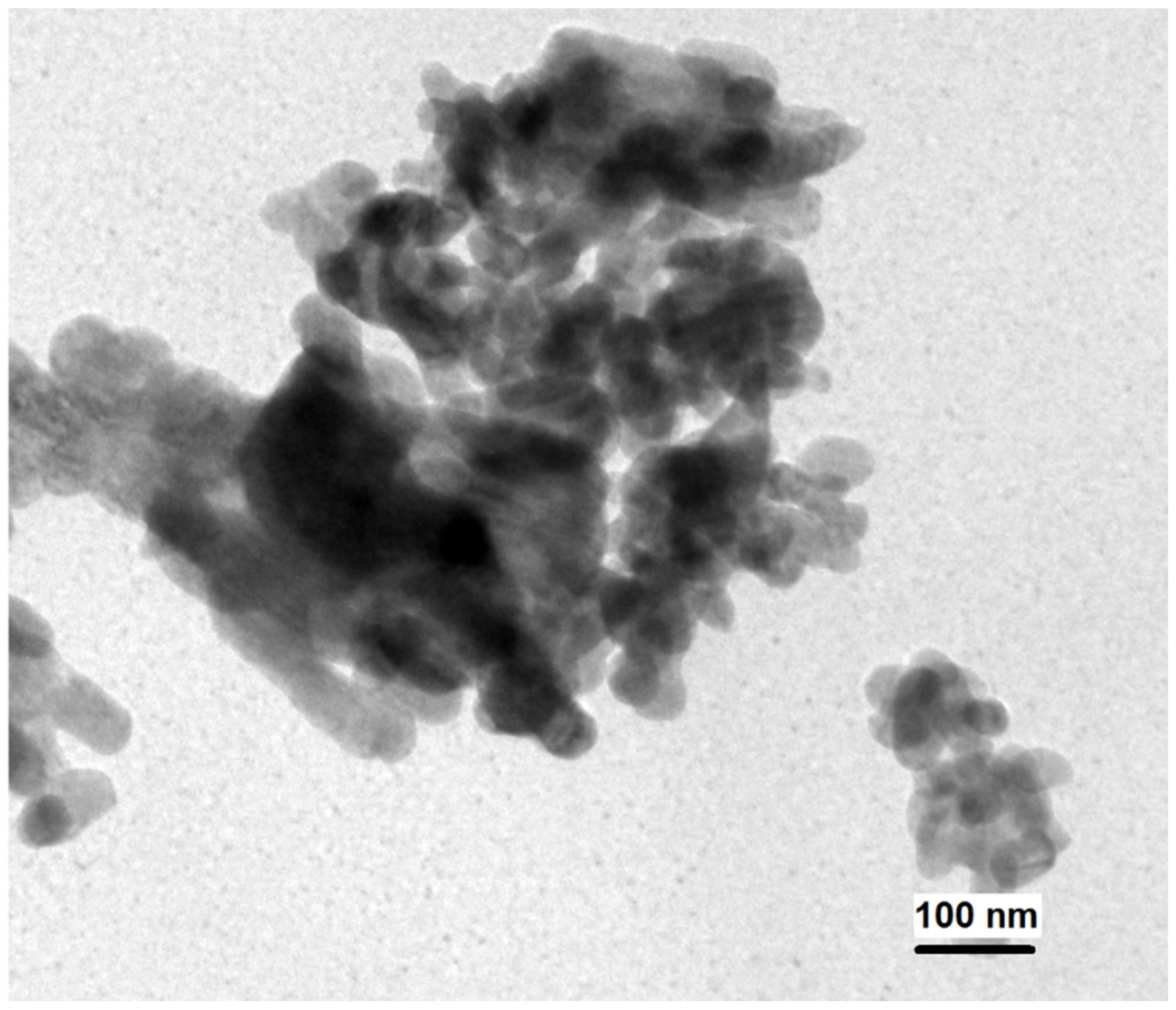
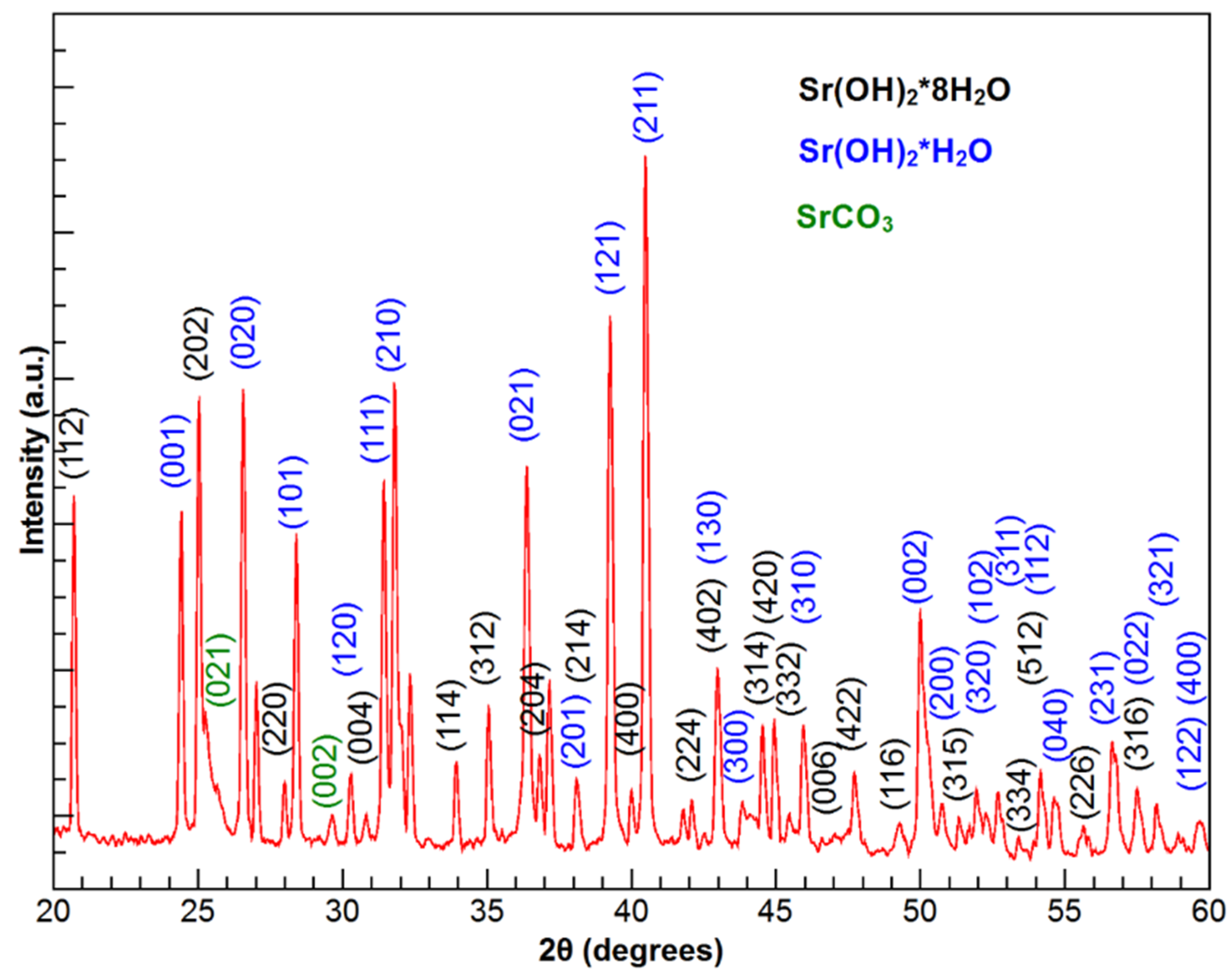
2.1.3. Photocatalytic Activity
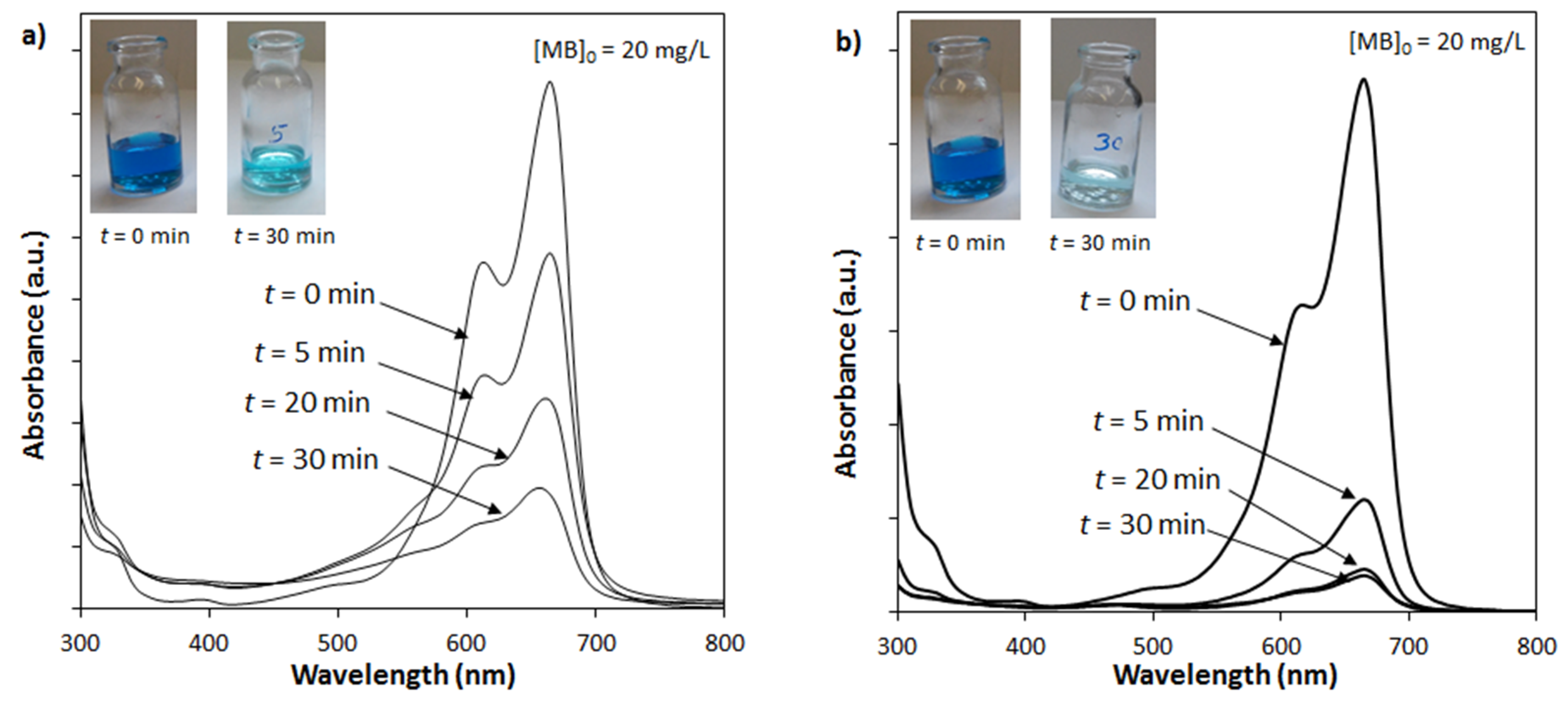
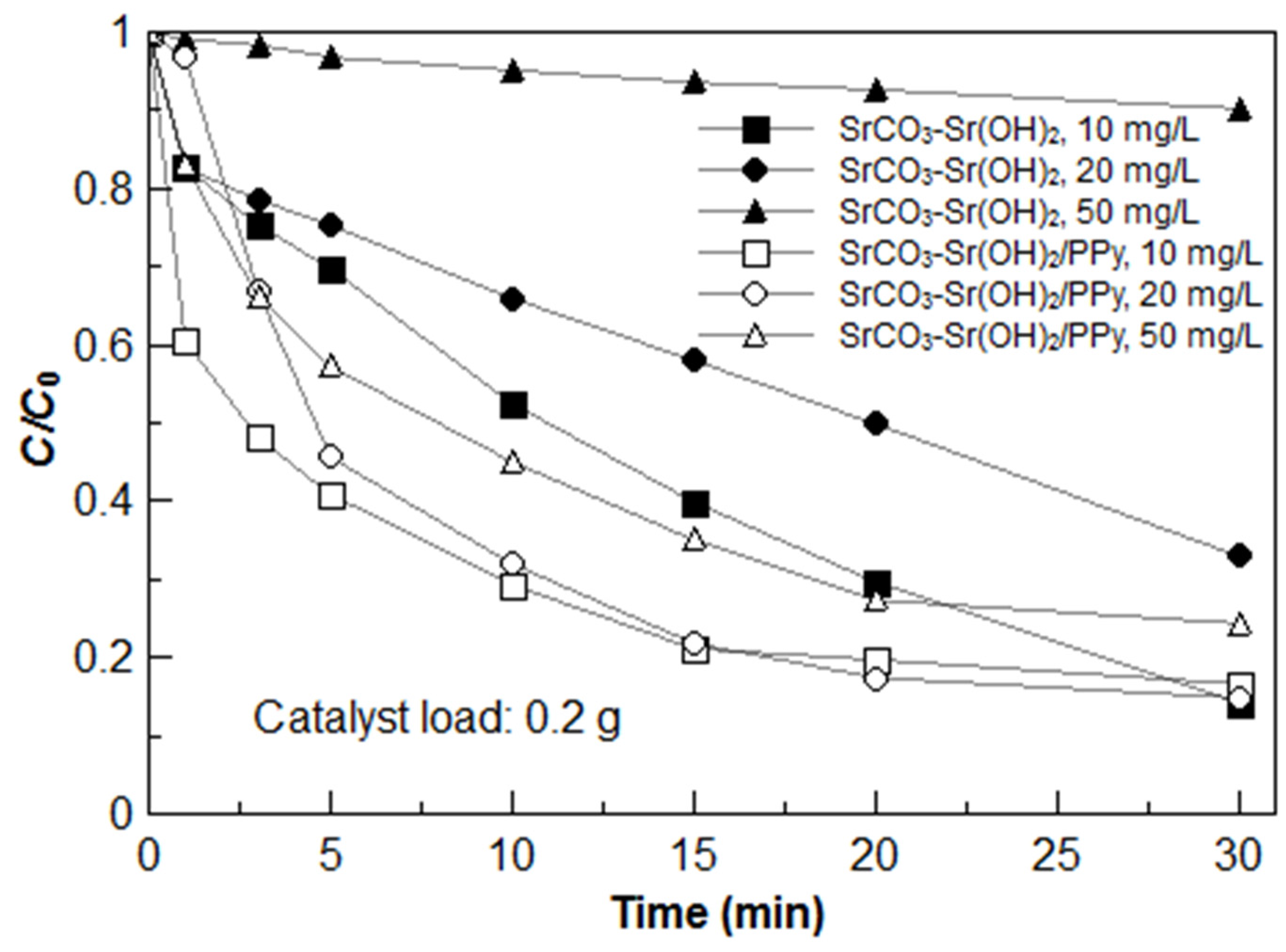
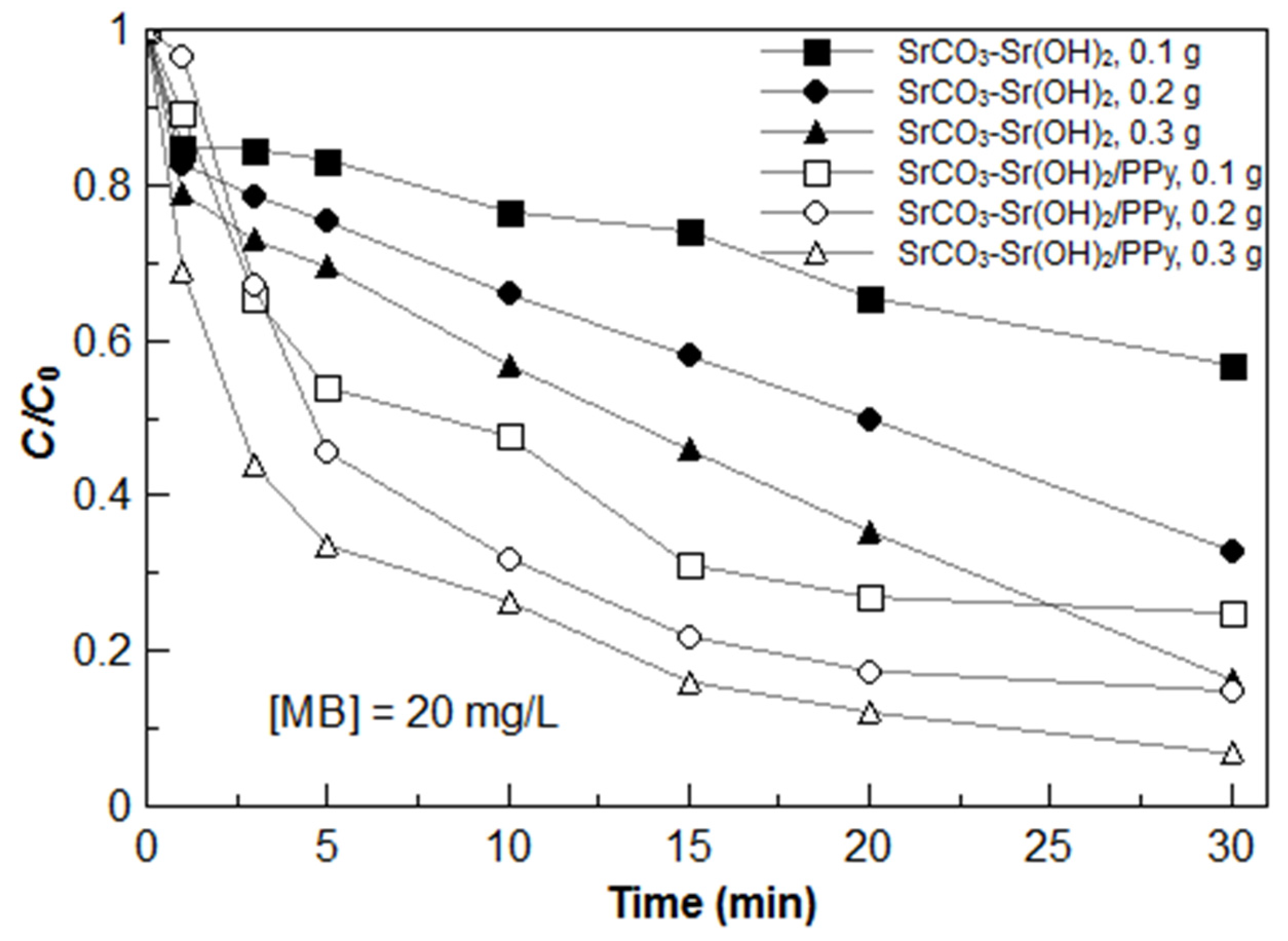
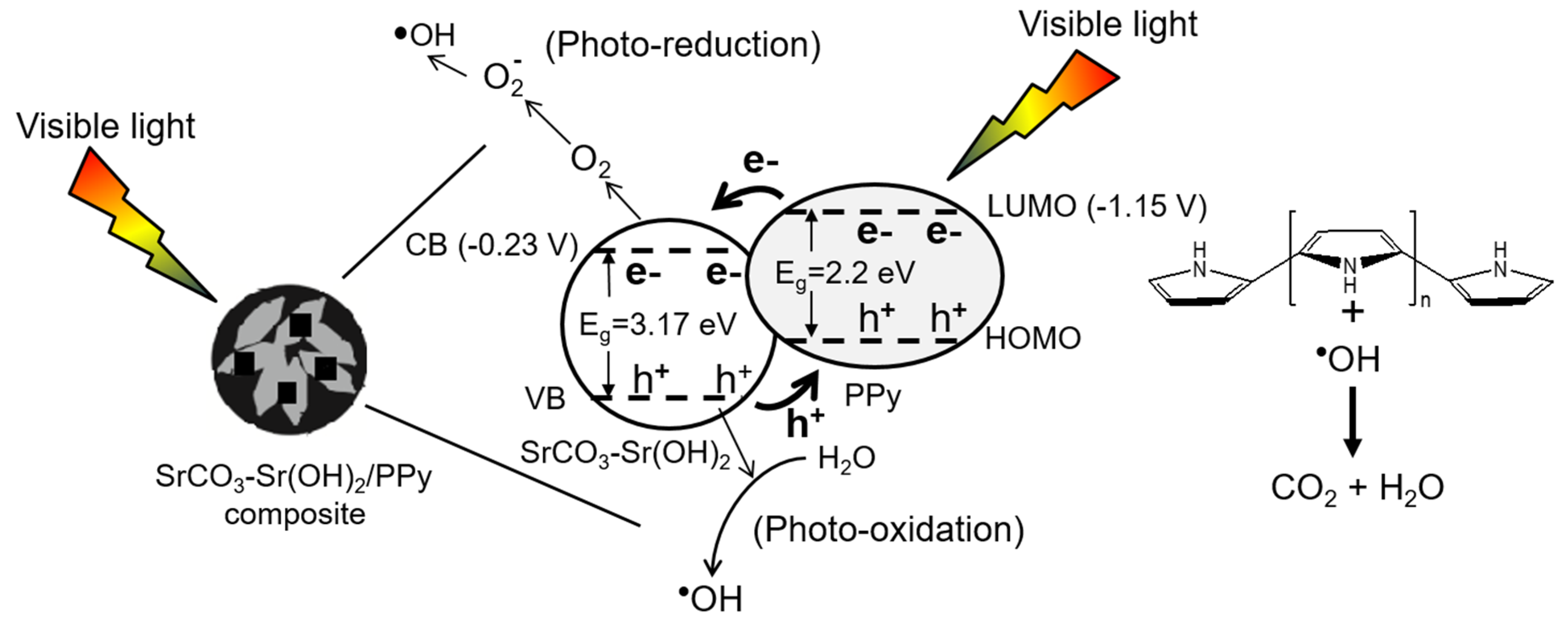
3. Materials and Methods
3.1. Materials
3.2. Methods
3.2.1. Synthesis of SrCO3-Sr(OH)2/PPy Nanocomposite
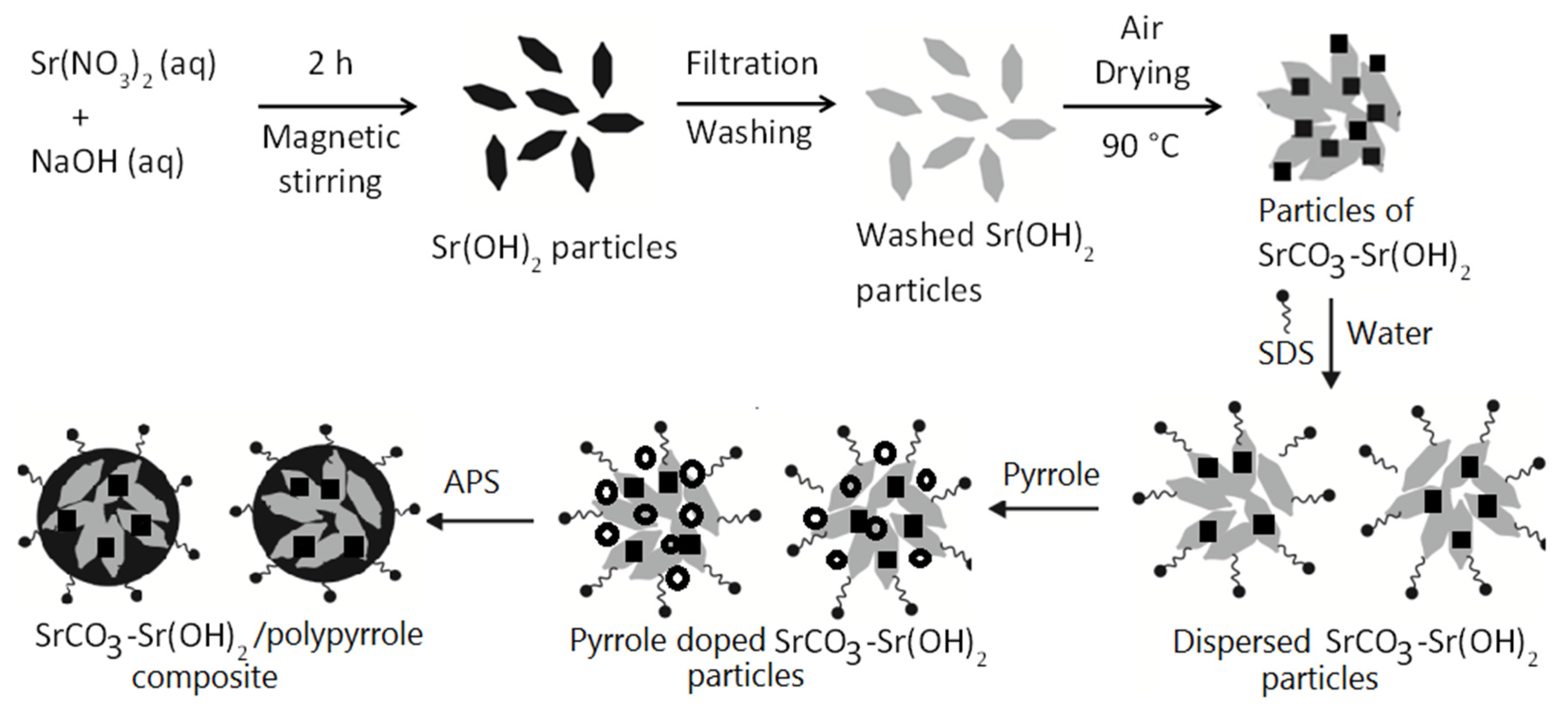
3.2.2. Characterization
3.2.3. Photoactivity in the Visible Light of Synthesized Materials
4. Conclusions
Supplementary Materials
Acknowledgments
Author Contributions
Conflicts of Interest
References
- Asahi, R.; Morikawa, T.; Ohwaki, T.; Aoki, K.; Taga, Y. Visible-light photocatalysis in nitrogen-doped titanium oxides. Science 2001, 293, 269–271. [Google Scholar] [CrossRef] [PubMed]
- Tang, J.; Zou, Z.; Ye, J. Efficient photocatalytic decomposition of organic contaminants over CaBi2O4 under visible-light irradiation. Angew. Chem. Int. Ed. 2004, 43, 4463–4466. [Google Scholar] [CrossRef] [PubMed]
- Kim, T.W.; Hwang, S.-J.; Jhung, S.H.; Chang, J.-S.; Park, H.; Choi, W.; Choy, J.H. Photolysis: Nickel oxide-containing porous nanocomposite. Adv. Mater. 2008, 20, 539–542. [Google Scholar] [CrossRef]
- Hameed, A.; Montini, T.; Gombac, V.; Fornasiero, P. Surface phases and photocatalytic activity correlation of Bi2O3/Bi2O4-x nanocomposite. J. Am. Chem. Soc. 2008, 130, 9658–9659. [Google Scholar] [CrossRef] [PubMed]
- Zeng, J.; Wang, H.; Zhang, Y.; Zhu, M.K.; Yan, H. Hydrothermal synthesis and photocatalytic properties of pyrochlore La2Sn2O7 nanocubes. J. Phys. Chem. C 2007, 111, 11879–11887. [Google Scholar] [CrossRef]
- Liu, J.W.; Chen, G.; Li, Z.H.; Zhang, Z.G. Electronic structure and visible light photocatalysis water splitting property of chromium-doped SrTiO3. J. Solid State Chem. 2006, 179, 3704–3708. [Google Scholar] [CrossRef]
- Fujishima, A.; Honda, K. Electrochemical photolysis of water at a semiconductor electrode. Nature 1972, 238, 37–38. [Google Scholar] [CrossRef] [PubMed]
- Yang, J.; Li, D.; Wang, X.; Yang, X.J.; Lu, L.D. Rapid synthesis of nanocrystalline TiO2/SnO2 binary oxides and their photoinduced decomposition of methyl orange. J. Solid State Chem. 2002, 165, 193–198. [Google Scholar] [CrossRef]
- Wang, C.; Zhao, J.C.; Wang, X.M.; Mai, B.X.; Sheng, G.Y.; Peng, P.A.; Fu, J.M. Preparation, characterization and photocatalytic activity of nano-sized ZnO/SnO2 coupled photocatalysts. Appl. Catal. B Environ. 2002, 39, 269–279. [Google Scholar]
- Yamashita, H.; Harada, M.; Misaka, J.; Takeuchi, M.; Ikeue, K.; Anpo, M. Degradation of propanol diluted in water under visible light irradiation using metal ion-implanted titanium dioxide photocatalysts. J. Photochem. Photobiol. A Chem. 2002, 148, 257–261. [Google Scholar] [CrossRef]
- Herrmann, J.M. Heterogeneous photocatalysis: Fundamentals and applications to the removal of various types of aqueous pollutants. Catal. Today 1999, 53, 115–129. [Google Scholar] [CrossRef]
- Matos, J.; Garcia, A.; Zhao, L.; Magdalena-Titirici, M. Solvothermal carbon-doped TiO2 photocatalyst for the enhanced methylene blue degradation under visible light. Appl. Catal. A Gen. 2010, 390, 175–182. [Google Scholar] [CrossRef]
- Kachina, A.; Puzenat, E.; Ould-Chikh, S.; Geantet, C.; Delichere, P.; Afanasiev, P. A new approach to the preparation of nitrogen-doped titania visible light photocatalyst. Chem. Mater. 2012, 24, 636–642. [Google Scholar] [CrossRef]
- Wang, J.; Yin, S.; Komatsu, M.; Zhang, Q.; Saito, F.; Sato, T. Preparation and characterization of nitrogen doped SrTiO3 photocatalyst. J. Photochem. Photobiol. A Chem. 2004, 165, 149–156. [Google Scholar] [CrossRef]
- Chang, C.H.; Shen, Y.H. Synthesis and characterization of chromium doped SrTiO3 photocatalyst. Mater. Lett. 2006, 60, 129–132. [Google Scholar] [CrossRef]
- Xie, T.H.; Sun, X.; Lin, J. Enhanced photocatalytic degradation of RhB driven by visible light-induced MMCT of Ti(IV)−O−Fe(II) formed in Fe-doped SrTiO3. J. Phys. Chem. C 2008, 112, 9753–9759. [Google Scholar] [CrossRef]
- Sulaeman, U.; Yin, S.; Suehiro, T.; Sato, T. Solvothermal synthesis of SrTiO3-LnTiO2N solid solution and their visible light responsive photocatalytic properties. IOP Conf. Ser. Mater. Sci. Eng. 2009, 1. [Google Scholar] [CrossRef]
- Ouyang, S.; Tong, H.; Umezawa, N.; Cao, J.; Li, P.; Bi, Y.; Zhang, Y.; Ye, J. Surface alkalinization induced enhancement of photocatalytic H2 evolution over SrTiO3 based photocatalysts. J. Am. Chem. Soc. 2012, 134, 1974–1977. [Google Scholar] [CrossRef] [PubMed]
- Nishiro, R.; Tanaka, S.; Kudo, A. Hydrothermal-synthesized SrTiO3 photocatalyst codoped with rhodium and antimony with visible-light response for sacrificial H2 and O2 evolution and application to overall water splitting. Appl. Catal. B Environ. 2014, 150, 187–196. [Google Scholar] [CrossRef]
- Shen, S.; Jia, Y.; Fan, F.; Feng, Z.; Li, C. Time-resolved infrared spectroscopic investigation of roles of valence states of Cr in (La,Cr)-doped SrTiO3 photocatalysts. Chin. J. Catal. 2013, 34, 2036–2040. [Google Scholar] [CrossRef]
- Subramanian, V.; Roeder, R.K.; Wolf, E.E. Synthesis and UV-visible-light photoactivity of noble-metal-SrTiO3 composites. Ind. Eng. Chem. Res. 2006, 45, 2187–2193. [Google Scholar] [CrossRef]
- Ueda, M.; Otsuka-Yao-Matsuo, S. Preparation of tabular TiO2–SrTiO3-δ composite for photocatalytic electrode. Sci. Technol. Adv. Mater. 2004, 5, 187–193. [Google Scholar] [CrossRef]
- Jia, Q.; Iwase, A.; Kudo, A. BiVO4-Ru/SrTiO3: Rh composite Z-scheme photocatalyst for solar water splitting. Chem. Sci. 2014, 5, 1513–1519. [Google Scholar] [CrossRef]
- Guo, J.; Ouyang, S.; Li, P.; Zhang, Y.; Kako, T.; Ye, J. A new heterojunction Ag3PO4/Cr-SrTiO3 photocatalyst towards efficient elimination of gaseous organic pollutants under visible light irradiation. Appl. Catal. B Environ. 2013, 134, 286–292. [Google Scholar] [CrossRef]
- Zhang, H.; Wu, X.; Wang, Y.; Chen, X.; Li, Z.; Yu, T.; Ye, J.; Zou, Z. Preparation of Fe2O3/SrTiO3 composite powders and their photocatalytic properties. J. Phys. Chem. Solids 2007, 68, 280–283. [Google Scholar] [CrossRef]
- Márquez-Herrera, A.; Ovando-Medina, V.M.; Castillo-Reyes, B.E.; Meléndez-Lira, M.; Zapata-Torres, M.; Saldaña, N. A novel synthesis of SrCO3–SrTiO3 nanocomposites with high photocatalytic activity. J. Nanopart Res. 2014, 16, 1–10. [Google Scholar] [CrossRef]
- Del-Ángel-Sánchez, M.T.; García-Alamilla, P.; Lagunes-Gálvez, L.M.; García-Alamilla, R.; Cabrera-Culebro, E.G. Aplicación de metodología de superficie de respuesta para la degradación de naranja de metilo con TiO2 sol-gel sulfatado. Rev. Int. Contam. Ambient. 2015, 31, 99–106. [Google Scholar]
- Mousavi, M.; Habibi-Yangjeh, A. Ternary g-C3N4/Fe3O4/Ag3VO4 nanocomposites: Novel magnetically separable visible-light-driven photocatalysts for efficientlydegradation of dye pollutants. Mater. Chem. Phys. 2015, 163, 421–430. [Google Scholar] [CrossRef]
- Zhu, S.B.; Xu, T.G.; Fu, H.B.; Zhao, J.C.; Zhu, Y.F. Synergetic effect of Bi2WO6 photocatalyst with C60 and enhanced photoactivity under visible irradiation. Environ. Sci. Technol. 2007, 41, 6234–6239. [Google Scholar] [CrossRef] [PubMed]
- Shang, M.; Wang, W.Z.; Sun, S.M.; Ren, J.; Zhou, L.; Zhang, L. Efficient visible light-induced photocatalytic degradation of contaminant by spindle-like PANI/BiVO4. J. Phys. Chem. C 2009, 113, 20228–20233. [Google Scholar] [CrossRef]
- Liang, H.C.; Li, X.Z. Visible-induced photocatalytic reactivity of polymer-sensitized titania nanotube films. Appl. Catal. B 2009, 86, 8–17. [Google Scholar] [CrossRef]
- Luo, Q.Z.; Li, X.Y.; Wang, D.S.; Wang, Y.H.; An, J. Photocatalytic activity of polypyrrole/TiO2 nanocomposites under visible and UV light. J. Mater. Sci. 2011, 46, 1646–1654. [Google Scholar] [CrossRef]
- Kandiel, T.A.; Dillert, R.; Bahnemann, D.W. Enhanced photocatalytic production of molecular hydrogen on TiO2 modified with Pt-polypyrrole nanocomposites. Photochem. Photobiol. Sci. 2009, 8, 683–690. [Google Scholar] [CrossRef] [PubMed]
- Cooper, G.; Noufi, R.; Frank, A.J.; Nozik, A.J. Oxygen evolution on tantalum-polypyrrole-platinum anodes. Nature 1982, 295, 578–580. [Google Scholar] [CrossRef]
- Chowdhury, D.; Paul, A.; Chattopadhyay, A. Photocatalytic polypyrrole-TiO2-nanoparticles composite thin film generated at the air-water interface. Langmuir 2005, 21, 4123–4128. [Google Scholar] [CrossRef] [PubMed]
- Zhang, C.R.; Li, Q.L.; Li, J.Q. Synthesis and characterization of polypyrrole/TiO2 composite by in situ polymerization method. Synth. Met. 2010, 160, 1699–1703. [Google Scholar] [CrossRef]
- Wang, D.S.; Wang, Y.H.; Li, X.Y.; Luo, Q.Z.; An, J.; Yue, J.X. Sunlight photocatalytic activity of polypyrrole-TiO2 nanocomposites prepared by “in situ” method. Catal. Comm. 2008, 9, 1162–1166. [Google Scholar] [CrossRef]
- Yang, Y.; Wen, J.; Wei, J.; Xiong, R.; Shi, J.; Pan, C. Polypyrrole-decorated Ag-TiO2 nanofiber exhibiting enhanced photocatalytic activity under visible-light illumination. Appl. Mater. Interfaces 2013, 5, 6201–6207. [Google Scholar] [CrossRef] [PubMed]
- Zhang, Z.; Wang, W.; Gao, E. Polypyrrole/Bi2WO6 composite with high charge separation efficiency and enhanced photocatalytic activity. J. Mater. Sci. 2014, 49, 7325–7332. [Google Scholar] [CrossRef]
- An, L.; Wang, G.; Shi, X.; Su, M.; Gao, F.; Cheng, Y. Recyclable Fe3O4/ZnO/PPy composite photocatalyst: Fabrication and photocatalytic activity. Russ. J. Phys. Chem. A 2014, 88, 2419–2423. [Google Scholar] [CrossRef]
- Wang, Q.; Zheng, L.; Chen, Y.; Fang, J.; Huang, H.; Su, B. Synthesis and characterization of novel PPy/Bi2O2CO3 composite with improved photocatalytic activity for degradation od Rhodamine-B. J. Alloy. Compd. 2015, 637, 127–132. [Google Scholar] [CrossRef]
- Song, L.; Zhang, S.; Chen, B. A novel visible-light-sensitive strontium carbonate photocatalyst with high photocatalytic activity. Catal. Commun. 2009, 10, 1565–1568. [Google Scholar] [CrossRef]
- Alavi, M.A.; Morsali, A. Syntheses and characterization of Sr(OH)2 and SrCO3 nanostructures by ultrasonic method. Ultrason. Sonochem. 2010, 17, 132–138. [Google Scholar] [CrossRef] [PubMed]
- Li, L.; Lin, R.; Tong, Z.; Feng, Q. Facile synthesis of SrCO3 nanostructures in methanol/water solution without additives. Nanoscale Res. Lett. 2012, 7, 305. [Google Scholar] [CrossRef] [PubMed]
- Mondal, M.K.; Lenka, M. Solubility of CO2 in aqueous strontium hydroxide. Fluid Ph. Equilib. 2012, 336, 59–62. [Google Scholar] [CrossRef]
- Momenian, H.R.; Gholamrezaei, S.; Salavati-Niasari, M.; Pedram, B.; Mozaffar, F.; Ghanbari, D. Sonochemical synthesis and photocatalytic properties of metal hydroxide and carbonate (M:Mg, Ca, Sr or Ba) Nanoparticles. J. Clust. Sci. 2013, 24, 1031–1042. [Google Scholar] [CrossRef]
- Song, L.; Li, Y.; He, P.; Zhang, S.; Wu, X.; Fang, S.; Shan, J.; Sun, D. Synthesis and sonocatalytic property of rod-shape Sr(OH)2·8H2O. Ultrason. Sonochem. 2014, 21, 1318–1324. [Google Scholar] [CrossRef] [PubMed]
- Ovando-Medina, V.M.; Martínez-Gutiérrez, H.; Corona-Rivera, M.A.; Cervantes-González, E.; Flores-Mejía, J.; Farías-Cepeda, L. Silver/silver bromide/polypyrrole nanoparticles obtained by microemulsion photopolymerization in the presence of a cationic surfactant. Colloid. Polym. Sci. 2013, 291, 605–615. [Google Scholar] [CrossRef]
- Naumkin, A.V.; Kraut-Vass, A.; Gaarenstroom, S.W.; Powell, C.J. NIST X-ray Photoelectron Spectroscopy Database, Version 4.1. National Institute of Standards and Technology: Gaithersburg, 2012. Available online: http://srdata.nist.gov/xps/ (accessed on 22 September 2015). [Google Scholar]
- Castillo-Reyes, B.E.; Ovando-Medina, V.M.; Omar González-Ortega, O.; Alonso-Dávila, P.A.; Juárez-Ramírez, I.; Martínez-Gutiérrez, H.; Márquez-Herrera, A. TiO2/polypyrrole nanocomposites photoactive under visible light synthesized by heterophase polymerization in the presence of different surfactants. Res. Chem. Intermed. 2015, 41, 8211–8231. [Google Scholar] [CrossRef]
- Viriya-empikul, N.; Changsuwan, P.; Faungnawakij, K. Preparation of strontium-based fibers via electrospinning technique. Ceram. Int. 2012, 38, 2633–2636. [Google Scholar] [CrossRef]
- Hoffmann, M.R.; Martin, S.T.; Choi, W.; Bahnemann, D.W. Environmental applications of semiconductor photocatalysis. Chem. Rev. 1995, 95, 69–96. [Google Scholar] [CrossRef]
- Hassan, M.E.; Chen, J.; Liu, G.; Zhu, D.; Cai, J. Enhanced photocatalytic degradation of methyl orange dye under the daylight irradiation over CN-TiO2 modified with OMS-2. Materials 2014, 7, 8024–8036. [Google Scholar] [CrossRef]
- Ni, S.; Yang, X.; Li, T. Hydrothermal synthesis and photoluminescence properties of SrCO3. Mater. Lett. 2010, 65, 766–768. [Google Scholar] [CrossRef]
- Cho, M.H.; Lee, Y.S. Optical detection of Mn impurity in oxides: A case study of Sr(NO3)2 and SrCO3. New Phys. Sae Mulli 2014, 64, 891–895. [Google Scholar] [CrossRef]
- Li, S.; Chen, M.; He, L.; Xu, F.; Zhao, G. Preparation and characterization of polypyrrole/TiO2nanocomposite and its photocatalytic activity under visible light irradiation. J. Mater. Res. 2009, 24, 2547–2554. [Google Scholar] [CrossRef]
- Scaife, D.E. Oxide semiconductors in photoelectrochemical conversion of solar energy. Solar Energy 1980, 25, 41–54. [Google Scholar] [CrossRef]
- Shirley, D.A. High-resolution X-Ray photoemission spectrum of the valence bands of gold. Phys. Rev. B 1972, 5, 4709–4714. [Google Scholar] [CrossRef]
- Rietveld, H.M. Line profiles of neutron powder-diffraction peaks for structure refinement. Acta Cryst. 1967, 22, 151–152. [Google Scholar] [CrossRef]
- Lutterotti, L.; Bortolotti, M.; Ischia, G.; Lonardelli, I.; Wenk, H.-R. Rietveld texture analysis from diffraction images. Z. Kristallogr. Suppl. 2007, 26, 125–130. [Google Scholar] [CrossRef]
- Leite, E.R.; Nobre, M.A.L.; Cerqueira, M.; Longo, E. Particle growth during calcination of polycation oxides synthesized by the polymeric precursors method. J. Am. Ceram. Soc. 1997, 80, 2649–2657. [Google Scholar] [CrossRef]
© 2016 by the authors; licensee MDPI, Basel, Switzerland. This article is an open access article distributed under the terms and conditions of the Creative Commons by Attribution (CC-BY) license (http://creativecommons.org/licenses/by/4.0/).
Share and Cite
Márquez-Herrera, A.; Ovando-Medina, V.M.; Castillo-Reyes, B.E.; Zapata-Torres, M.; Meléndez-Lira, M.; González-Castañeda, J. Facile Synthesis of SrCO3-Sr(OH)2/PPy Nanocomposite with Enhanced Photocatalytic Activity under Visible Light. Materials 2016, 9, 30. https://doi.org/10.3390/ma9010030
Márquez-Herrera A, Ovando-Medina VM, Castillo-Reyes BE, Zapata-Torres M, Meléndez-Lira M, González-Castañeda J. Facile Synthesis of SrCO3-Sr(OH)2/PPy Nanocomposite with Enhanced Photocatalytic Activity under Visible Light. Materials. 2016; 9(1):30. https://doi.org/10.3390/ma9010030
Chicago/Turabian StyleMárquez-Herrera, Alfredo, Victor Manuel Ovando-Medina, Blanca Estela Castillo-Reyes, Martin Zapata-Torres, Miguel Meléndez-Lira, and Jaquelina González-Castañeda. 2016. "Facile Synthesis of SrCO3-Sr(OH)2/PPy Nanocomposite with Enhanced Photocatalytic Activity under Visible Light" Materials 9, no. 1: 30. https://doi.org/10.3390/ma9010030




